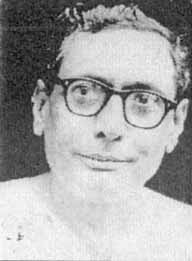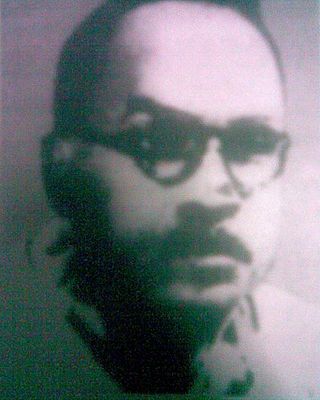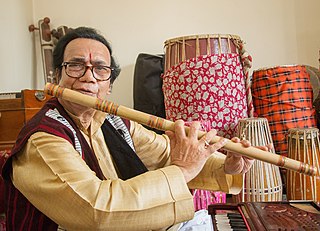Related Research Articles

Mājuli or Majuli is a river island in the Brahmaputra River, Assam state, India. On September 8, 2016 an additional district was announced by Sarbananda Sonowal, it became the first island to be made a district in India. In the 1790s, the island covered an area of 1,300 km2 (500 sq mi). It had an area of 1,255 square kilometres (485 sq mi) at the beginning of the 20th century, but having lost significantly to erosion it covers 352 square kilometres (136 sq mi) as at 2014. Majuli has shrunk as the river surrounding it has grown.
Saptakanda Ramayana is the 14th-15th century Assamese version of the Ramayana attributed to the famous Assamese poet Madhava Kandali. It is considered to be one of the earliest translations from the Sanskrit into a modern regional language, preceded only by Kambar's translation into Tamil and Ranganatha's translation into Telugu, and the first translation to an Indo-Aryan language. The work is also considered one of the earliest written examples of Assamese.

Ekasarana Dharma is a neo-Vaishnavite monolithic sect propagated by Srimanta Sankardeva in the 15th-16th century in the Indian state of Assam. It reduced focus on Vedic ritualism and focuses on devotion (bhakti) to Krishna in the form of congregational listening (shravan) and singing his name and deeds (kirtan).

Assamese literature is the entire corpus of poetry, novels, short stories, plays, documents and other writings in the Assamese language. It also includes the literary works in the older forms of the language during its evolution to the contemporary form and its cultural heritage and tradition. The literary heritage of the Assamese language can be traced back to the c. 9–10th century in the Charyapada, where the earliest elements of the language can be discerned.

Assamese cinema, is an Indian film industry of Assamese-language. It is based in Assam, India. The industry was born in 1935 when Jyoti Prasad Agarwala released his movie Joymoti. Since then the Assamese cinema has developed a slow-paced, sensitive style. In beginning the industry were called Jollywood, named for Agarwala's Jyoti Chitraban Film Studio.
Bhabendra Nath Saikia was a novelist, short-story writer, editor and film director from Assam, India. Dr. Saikia received his doctorate in physics from the University of London. He began his career as a reader in the Department of Physics, University of Guwahati. He later played an important role in the publication of college level textbooks in the Assamese language during his tenure as the Secretary of the Co-ordination Committee for production of textbooks in regional languages.
Though the precise Etymology of Assam, a state in India is unclear—there is general agreement that it is related to the Ahom people. Whatever the source of the English name, Assam is itself an anglicization.

Phani Sarma (1910–1970) was an Indian theatre actor, playwright, film actor and director. Beginning as a stage actor, he appeared in the first film ever made in Assamese cinema, Joymati, in 1935. Sarma was conferred with the title "Natasurya" for his contribution towards Assamese drama.

Prof Bhabananda Deka was a pioneer Assam economist and author who conducted novel research on the economy of the far eastern part of India. He was also a leading Indian-Assamese litterateur of the famed 'Awahon-Ramdhenu Era' of Assamese literature during the mid-20th century. He was the author of a total of 115 English and Assamese books including textbooks on a range of fifteen subjects including economics, ancient Assamese literature, philosophy, education, religion, mythology, archaeology, tribal study, poetry, drama, memoirs, civics, political science, biographies; he also edited books and journals. He also authored a variety of research papers and articles about the state of Assam, a state in the north-eastern part of India. He pioneered the writing of books on Economics in Assamese. His Assamese book Axomor Arthaneeti was the first ever research-based comprehensive book on Assam Economics, which was published for the first time in 1963. He was conferred with the honorary title of 'Asom Ratna' -- 'Jewel of Assam' by the intellectuals of Assam on 19 August 2007 at a public meet held under the presidency of Prof. (Dr) Satyendra Narayan Goswami.
The Kirtan Ghosha is a collection of poetical works, primarily composed by the medieval saint Srimanta Sankardev in the Brajavali language. It was meant for community singing in the Ekasarana religion. Its importance in the religion is second only to the primary text, the Bhagavat of Sankardeva.

Borgeets are a collection of lyrical songs that are set to specific ragas but not necessarily to any tala. These songs, composed by Srimanta Sankardeva and Madhavdeva in the 15th-16th centuries, are used to begin prayer services in monasteries, e.g. Satra and Namghar associated with the Ekasarana Dharma; and they also belong to the repertoire of Music of Meghalaya outside the religious context. They are a lyrical strain that express the religious sentiments of the poets reacting to different situations, and differ from other lyrics associated with the Ekasarana Dharma. Similar songs composed by others are not generally considered borgeets.

Banikanta Kakati was a prominent linguist, literary figure, critic and scholar in Assamese language with his immense contribution to the language in terms of literature, linguistics, cultural anthropology and comparative religion.

Vrindavani Vastra is a drape woven by Assamese weavers led by Mathuradas Burha Aata during 16th century under the guidance of Srimanta Sankardeva, a Vaishnavite saint and scholar who lived in present-day Assam. The lead weaver Mathuradas Burha Aata a disciple of Sri Sri Madhabdev, who was the first Satradhikar of the Barpeta Satra. Mathuradas Burha Aata along with his 12 assistant weavers wove the Brindavani Bastra. The large drape illustrates the childhood activities of Lord Krishna in Vrindavan. Parts of the original Vrindavani vastra are presently owned by the Victoria and Albert Museum in London and Musee Guimet in Paris. The piece of cloth demonstrates the skillful weaving methods developed during medieval times and such complexity is rarely seen in present-day Assam.

Baharul Islam is an Indian theater actor. An alumnus of the National School of Drama, which he had joined in 1987 Baharul has acted in more than 80 plays, designed and directed 30 plays for his theater troupe Seagull. He is one of the busiest theatre artists in Assam. He is also a film actor who works in Assamese and Hindi films.
Poley Poley Urey Mon is a 2011 Indian Assamese language drama film directed by Timothy Das Hanche, produced by Phukan Konwar, Purnananda Gogoi and Beauty Baruah under the banner Hills Motion Pictures Association of Diphu. The casts of the movie are Nipon Goswami, Moloya Goswami, Barsha Rani Bishaya, Gayatri Mahanta, Ravi Sarma, Rimpi Das, Parineeta Borthakur, Tarun Arora, Mahika Sharma etc. Bollywood actor Raza Murad and former Assam CM Tarun Gogoi also performed a cameo in this movie.

Madhupur Satra is a religious institutional center associated with the Ekasarana tradition of Vaishnavism, situated in Cooch Behar, the Indian state of West Bengal. It was established by Assamese Vaishnavite monasteries for religious practices in the mid 16th-century during Koch kingdom (1515–1949). The great Bhakti Saint Mahapurusha Srimanta Sankardeva (1449–1568) and his disciple Mahapurusha Madhavadeva died here. Madhupur satra is also called as Dahmukutor than; 'dahmukut' means 'bhiti' or living houses of ten disciples (bhaktas) of Srimanta Sankardeva. The name satra originates in the Bhagavata Purana in Sanskrit (sattra), and is used in the sense of an assembly of devotees.
Surjya Kanta Hazarika is an Assamese litterateur, an eminent scholar, author, publisher, playwright, lyricist, composer, cultural activist, feature film and documentary maker, social worker and philanthropist. Hazarika is a recipient of the Padma Shri Award in 2008 for his contribution to Literature & Education. He is the current president of Asam Sahitya Sabha.

Prabhat Sarma was a folk exponent and flutist from Assam, India.
Sandyaraag is a black and white Assamese language film, directed and produced by Bhabendra Nath Saikia. It was released in theatre in 1977. The film was based on a story titled 'Banprastha'. The screenplay and dialogues were written by the director himself. Sandhyaraag was awarded with silver medal for best Assamese film in the 25th National Film Awards. It is the first Assamese film to be showcased in the Indian Panorama.
References
- ↑ "Assamese Animated Film Sarvagunakar Srimanta Sankardeva Release on November 11". Kothasobi. Archived from the original on 4 November 2016. Retrieved 22 October 2016.
- ↑ Sarmah, Rashmi (10 November 2010). "Sarbagunakar Srimanta Sankardeva- the first Assamese animated film". Nezine.